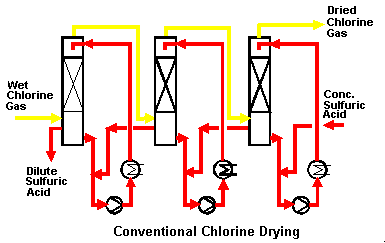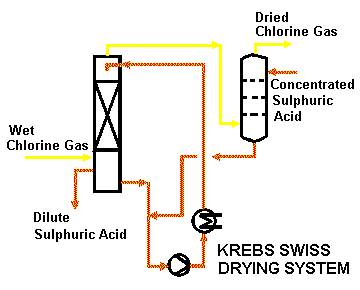The most common process for drying chlorine gas is the absorption of the residual
water vapour in concentrated sulfuric acid with minimum 98 % H2SO4.
Such acid is readily available in most places and has a very low water vapour
pressure. By the absorption of water vapour, the acid is diluted to about
75 to 80 % H2SO4.
At this concentration, the spent sulfuric acid after removal of the small
amount of dissolved chlorine can still be used for many other applications
or is reconcentrated in a sulfuric acid plant.
The absorption of the residual water vapour is connected with the generation of a substantial amount of heat which corresponds about to the heat of condensation of the water vapour plus the heat of dilution of the sulfuric acid. For maintaining a low operating temperature, this heat must be removed within the drying system.
Any sulfuric acid mist entrained with the dried chlorine gas is usually separated in an other gas filter, unless the dried chlorine gas is fed to sulfuric acid ring compressors where it anyway is again in contact with concentrated sulfuric acid.
Conventional chlorine gas drying systems usually consist of three packed columns connected in series with respect to the chlorine gas. Each of the three columns is equipped with a pump for circulating the sulfuric acid. The heat of absorption is removed in heat exchangers which are installed in the acid circulation systems of at least the first two drying columns. A third cooler in.the acid circulation system of the third column is frequently required to remove the power input to the acid circulation pump of this column. With the intensive acid recirculation, the acid concentration is almost uniform throughout each of the columns and corresponds to the concentration of the acid leaving the column. The fresh concentrated acid is first fed to the third column with respect to the chlorine gas flow. It overflows from the third column to the second column and from the second column to the first column, so that the spent, dilute acid overflows finally from the first column.

The chlorine gas drying system of Krebs Swiss consists of only two columns connected in series: First a packed column, followed by a column with special impingement baffle trays. The packed column is equipped with an acid circulation pump and a cooler and most of the water vapour is removed in this column. The small amount of water vapour remaining in the gas leaving the packed column is finally removed in the tray column, which replaces two packed columns of a conventional system.
The required very high absorption efficiency results from the installation of special baffles above the perforations of a kind of sieve trays. Size, shape and location of the baffles are carefully optimised for very intensive mixing of the acid and the gas and thus for unique absorption efficiency. Because only a small part of the total water vapours are absorbed in the tray column and no pump power is added to the column, there is no need for cooling the tray column. The gas temperature increases only marginally. Since the tray column has no acid recirculation, chlorine gas and acid are flowing strictly countercurrent. The feed acid is not diluted with recirculated acid. This further increases the absorption efficiency in comparison with a packed column with acid recirculation.
The overall gas side pressure drop of Krebs Swiss drying systems is comparable with that of conventional systems and very high turndown ratios are easily possible by integrating the system with the downstream chlorine gas compression.
Such systems comprising
only one packed column and a column with special impingement baffle trays
are operated since more than twenty years in the chloralkali plants designed
and supplied by Krebs Swiss. In comparison with conventional systems, the
Krebs Swiss system has several substantial advantages:
- Substantially lower cost for equipment, piping, civil constructions
and erection work.
- Substantially reduced cost for electric power.
- Substantiaily lower maintenance cost.
